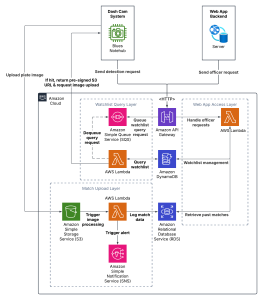Progress This Week
-
Completed Watchlist Management Layer (PR)
Implemented an AWS Lambda function for managing the global watchlist, integrating DynamoDB for storage and API Gateway for HTTP access. The system now supports adding, retrieving, and removing plates via secure API endpoints. All changes are covered by manual tests and automated Jest tests with CI/CD. -
Redesigned API Interface Based on Design Report Feedback
Based on the design report feedback, we adopted the “tip line” approach instead of a full web app. I redesigned the API interface to expose aPOSTendpoint for law enforcement agencies to add plates. See the team status report for detailed changes. -
Refactored for API-First Approach (PR)
Removed the web app dependency (no more officers) and restructured watchlist management endpoints (/plates) to work with API keys./detectionsnow only checks for plate matches without officer tracking, and/platesrequires an API key for modifications. The refactor simplifies external service integrations and is fully covered by automated tests.
In Progress
- Match Upload Implementation (Draft PR)
Implemented a Lambda function for extracting metadata, logging matches, and attaching images to S3. Integrated DynamoDB for match tracking. Currently testing and debugging before deployment.
Overall Status
- The project is on track with API refinements complete and match upload nearing finalization. Here’s a list of API endpoints ready for integration.




